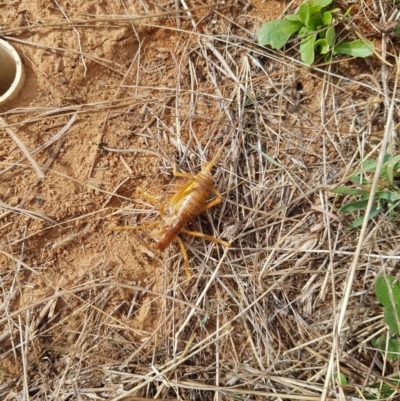Cooraboorama canberrae (Canberra Raspy Cricket)
The scientific name for the Canberra Raspy Cricket is Cooraboorama canberrae. It is the only species of the genus Cooraboorama. The insect is yellow-brown in colour and about 25 mm long. It digs a burrow in the soil up to 60 cm deep which it lines with a silk-like substance to keep the walls stable. It is nocturnal, emerging from its burrow at night to feed. It has mostly been found in native grasslands. Although it used to be quite common, urban expansion and farming practices have reduced its natural habitat considerably. It may also be affected by weed invasion and changes to the fire regimes of the past. The species has no wings and so does not fly. This limits its ability to move around the countryside so habitat fragmentation is a serious problem for it.
Unfortunately it has been neglected, and apart from the above there is very little specific knowledge about its food preferences, habits, life cycle or other habitat requirements. But I can give some additional general information about Raspy Crickets. The family Gryllacrididae is for Raspy Crickets or Leaf-rolling Crickets. Members of this family are nocturnal and omnivorous. Although they have strong back legs they do not jump. They have an annual life cycle, with the young nymphs emerging in spring and growing to adulthood by a series of moults. When mature they mate and create the next generation. Using her long ovipositor, the female lays her eggs in the soil, which overwinter there. They get their name ‘raspy’ from the sound they make when threatened.
The Canberra Raspy Cricket has not yet been formally recognized as threatened and officially is just considered to be rare. However there are people trying to change this and get the necessary listing and the government protection it deserves. Hopefully we can learn more about this insect and it will have a secure future.
Cooraboorama canberrae is listed in the following regions:
Canberra & Southern Tablelands | South Coast
Species information
- Cooraboorama canberrae Scientific name
- Canberra Raspy Cricket Common name
- Sensitive
- Very rare / threatened
- Non-invasive or negligible
- Machine learning
- External link More information




















